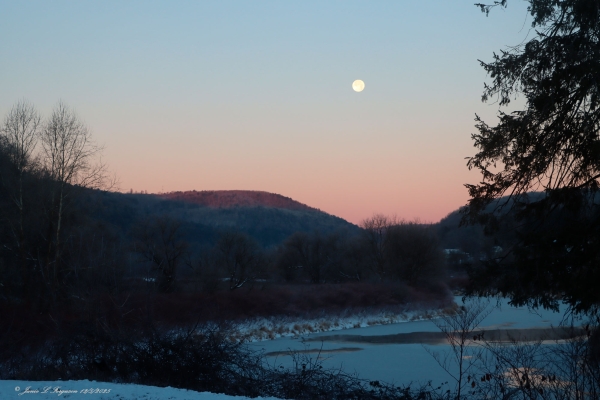The weather changes faster than ever in Western New York
A COLUMN By Kathryn Ross
As I sit here on my couch watching the flurries blow across my neighbor’s snow-covered backyard, listening to their tinkling windchimes, watching their tall trees swaying with the wind, and feeling the cold breezes seep through my window, I think of when I read this year’s winter prediction in the “Old Farmer’s Almanac”.
It was wrong, really wrong.
Like many of us who grew up in Wellsville, I’m a country girl at heart. I look to the horses to see how thick their winter coats are growing. I listen to the wind, watch the trees, look to see if the geese are flying south early and just generally “feel” from the temperature and the moisture in the air what the coming winter will bring.
I watch for the Woolly Bear caterpillars in the fall to see what their black and orange stripes will tell me.
Scientists say that the idea of a caterpillar predicting the weather is a myth. It makes me wonder why then, did it get to be so highly believed? The Woolly Bear is the larval stage of the Isabella Tiger Moth, a much less colorful creature. It can be found in the fall and hibernates during the winter and becomes a moth in the spring. Fully grown the caterpillar is about 1.5 inches long and covered with fine, bristly hair that is mainly black with an orange band. The color is the predictor. Old Wives say if the caterpillar’s orange band is wide it will be a mild winter and if the caterpillar is mostly black it will be a harsh winter.
I didn’t happen to spot any Woolly Bears this year.
I also read the “Old Farmers Almanac”. Aside from the annual winter predictions there are a lot of interesting and helpful articles and facts included in the pages of the Almanac that has been printed every year since 1792. But the weather forecast is the principal reason I try to pick up the Almanac when I see it in the store, even though the price has gone up dramatically since I started reading it. Today you can get an online version of the publication for $6.95. The regular price is $9.95 for the original paper version that is sold on magazine racks. You can also get a version with oversized text for those who are hard of seeing, for around $20. All are a far cry from what it used to cost when I picked it up in my younger years, but then isn’t everything?
This year I was particularly interested in what the Almanac had to say about winter especially since the headlines I saw stated, “Old Farmer’s Almanac Predicts a Calmer, Gentler Winter”.
Inside the pages, the Almanac’s Editor and Chief Carol Connair wrote, “This year, temperatures will be up and snowfall down throughout most of the United States. We’re predicting a temperate, uneventful winter, potentially a welcome reprieve from the extremes of recent years.”
Ah, since when are the low 20s to zero degrees, some form of snow either flurries or actual snowfall covering the roads and lawns calmer and gentler?
Then, I noticed the disclaimer in the Almanac stating that “On average the Almanac is traditionally 80-percent accurate.”
On another front, when it comes to predicting the weather, I’ve always been amused at the way NOAA, the National Oceanic and Atmospheric Administration, writes from its Climate Prediction Center for a season, caging their predictions in terms like – “likely conditions or average conditions.” Just goes to show you that weather prediction is not an exact science.
In their latest announcement NOAA said, “A slowly-developing La Nina is favored to influence conditions for the upcoming winter across most of the country, for December 2024 through February 2025 predicting wetter-than-average conditions for the entire northern tier of the continental U.S., particularly in the Pacific Northwest and the Great Lakes region, along with northern and western Alaska. Meanwhile, drier-than-average conditions are expected from the Four Corners region of the Southwest to the Southeast, Gulf Coast and lower mid-Atlantic states.”
NOAA seems to be about as accurate as the “The Old Farmer’s Almanac” on average. As for me, I’m going to stick to the horses and the caterpillars because the safest prediction for the weather in Western New York is, “Wait five minutes and it will change.”







